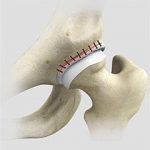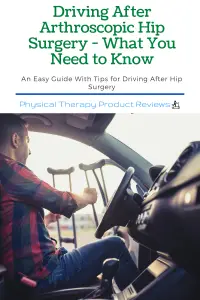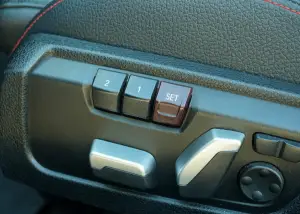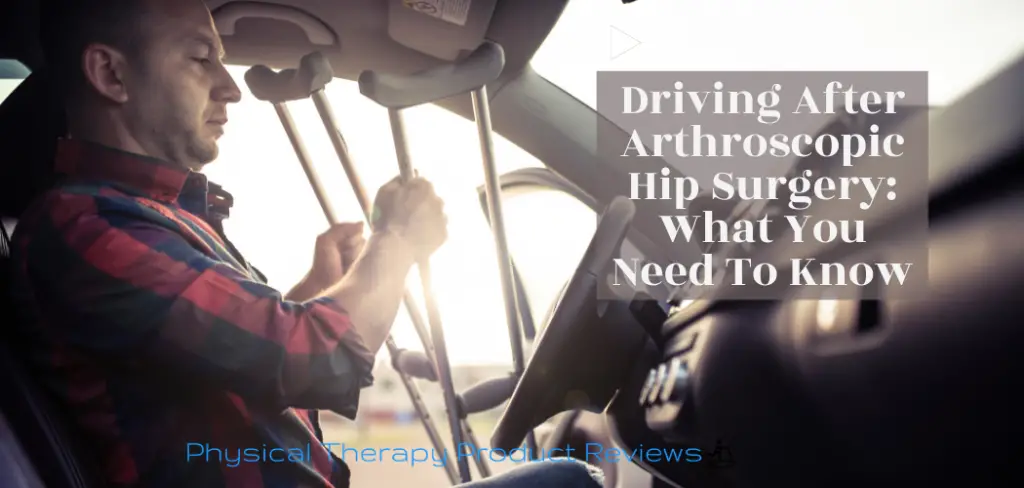Getting back to normal after arthroscopic hip surgery can be confusing and even frightening. Hip surgery, whether it was a hip labral repair, hip labral debridement, or a labral reconstruction, is a life-changing event that you want to allow to adequately heal.
See our helpful table and subsequent information to help you know when you can drive and some tips to make it more comfortable.
∗If in doubt always ask and clarify with your surgeon before driving or performing an activity in doubt*
How Long After Hip Labral Surgery Can You Drive
| Type of Surgery | Right Leg | Left Leg |
|---|---|---|
| Hip Labral Debridement | Within 1-2 Weeks* | Within 1-2 Days* |
| Hip Labral Repair | Within 4-6 Weeks* | Within 1-2 Weeks* |
| Hip Labral Reconstruction | AFter 6 Weeks* | Within 2-3 Weeks* |
∗ Denotes that you must be off narcotic pain medication before operating a vehible
What are the Different Types of Surgery for a Torn Labrum
Hip Labral Debridement
A Labral debridement is a surgery where the surgeon goes into the hip and cleans up the labrum and surrounding tissue but does not actually repair anything. This may include cutting any frayed or torn pieces of the labrum, they may shave some bone to prevent further friction on the surrounding tissue.
Hip Labral Repair
A hip Labral Repair is where the surgeon repairs the existing labrum. In this surgery, the labrum and surrounding tissue are debrided like the previous surgery but the labrum is then anchored down to the bone of the Acetabulum using sutures.
Hip Labral Reconstruction
The final and most involved hip Labral surgery is a Labral Reconstruction. In this surgery, the surgeon will use tissue from either a donor cadaver or from another area of the patient’s body such as the IT band. The surgeon creates a similar size and shape of the Labrum and then attaches it where the previously torn or damaged labrum was before. Due to the more extensive work, this surgery takes the longest to heal.

FAQ Regarding Driving After Arthroscopic Hip Surgery
What’s the Risk of Driving Too Soon After Surgery
 The risk of driving after surgery is due to the position that driving places the hip. The most common location for a Labral tear is the front or anterior portion. In a seated position, the anterior labrum has the least amount of room for movement and places it more risk for impingement.
The risk of driving after surgery is due to the position that driving places the hip. The most common location for a Labral tear is the front or anterior portion. In a seated position, the anterior labrum has the least amount of room for movement and places it more risk for impingement.
In healthy and happy hips this position is not an issue. For hips that just had surgery, the act of lifting the leg to switch pedals can cause irritation of the new surgical area.
Why Does it Matter if it is the Left or Right Leg?
This is important because of the motion of switching between pedals. If the surgery was performed on the left leg that you will be able to return to driving as soon as you are off pain meds and can safely get into the car.
If you had hip surgery on the right leg then you will have to wait longer to drive. The motion of switching from the gas pedal to the brake pedal can be problematic. When you are sitting with the hip flexed or bent above 90 degrees this increases the risk of hip impingement which is what you don’t want after surgery.
Can you Drive While on Pain Medication?
No, you cannot drive while on narcotic pain medication. This is a big deal. You can actually get a DUI if you are caught driving while under the influence of using narcotic pain medication. Save yourself the hassle and catch a ride for the first few weeks.
Helpful Tips for Driving After Hip Surgery
How to Get in/out of the Car After Hip Surgery
There are a couple of easy steps that you can do to make it easier to get into or out of a car after an arthroscopic hip surgery.
- Slide the front seat all the way back to make more room to twist in
- Back up to the seat and sit down before rotating
- Use your hands to help lift the surgical leg over the frame and on to the floor of the car
- Keep the seat in a more reclined position while riding in the car to prevent impingement at the hip at angles greater than 90 degrees of hip flexion
- Trucks, SUVs, and higher clearance vehicles are easier to get into than a sedan
- Try and keep your knee and leg straight while sitting to help with the angle of the hip
Change the Seat Settings
 Once you have mastered getting into the car there are a few seat settings that you can change to make it more comfortable to sit in the car.
Once you have mastered getting into the car there are a few seat settings that you can change to make it more comfortable to sit in the car.
- Try and raise the seat ported of the seat to have a lower angle at the hip
- Recline the seat more than normal
- Increase the support at the lumbar section
Ride in the Back Seat
If all else fails then the easiest and most comfortable option can be lying or slouching across the back seat. Patient’s often found this to be more comfortable during long road trips or if they find themselves in the car for long periods of time.
Sit on a Cushion
Finally, sitting on a seat cushion made for the car is a great idea. It decreases the angle of the surgical help and is more comfortable. You can also use the cushion as a prop for the leg.
In Review
Driving after hip surgery is something that many people don’t discuss with their medical providers. By being cautious and following proper guidelines you can be confident the surgery is healing and on when you can start to drive again.
Other Great Rehab Related Articles
How to Stay Active After Cervical Fractures: Expert Tips and Advice
Dealing with Painful Stairs After Ankle Replacement Surgery
Walking After a Total Ankle Replacement: Tips for a Successful Recovery
Exercises While Non-Weight Bearing After Ankle Replacement: Elevation, AROM, Leg Raises, and More
Ankle Pain with Stairs: Causes and Home Treatment Options
5 Common Mistakes You’re Making After an Ankle Sprain
Disclaimer: The information provided in this post is for educational purposes only. This is not a substitute for a medical appointment. Please refer to your physician before starting any exercise program.







